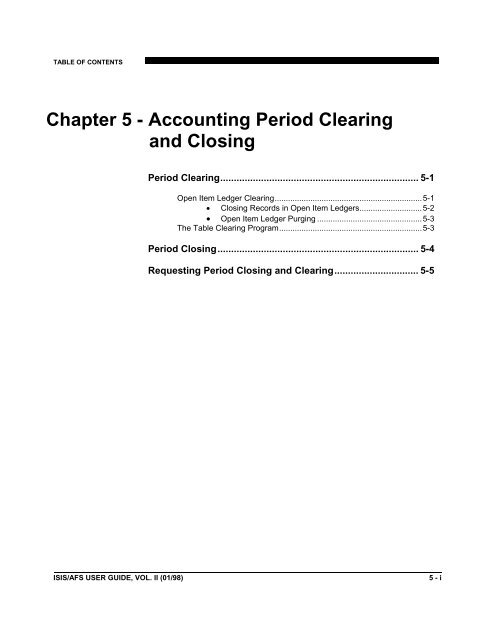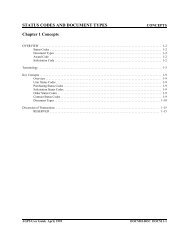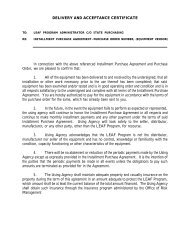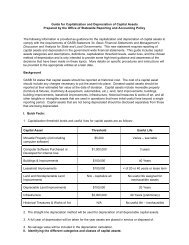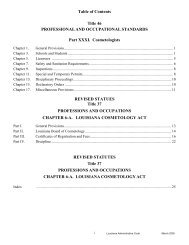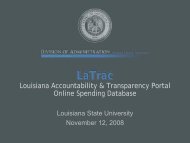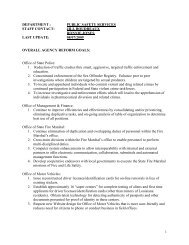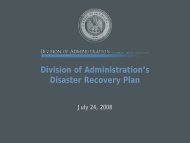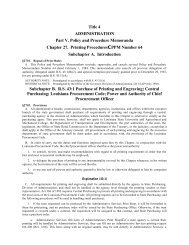Chapter 5 - Accounting Period Clearing & Closing
Chapter 5 - Accounting Period Clearing & Closing
Chapter 5 - Accounting Period Clearing & Closing
You also want an ePaper? Increase the reach of your titles
YUMPU automatically turns print PDFs into web optimized ePapers that Google loves.
CLEARING & CLOSING<strong>Chapter</strong> 5 - <strong>Accounting</strong> <strong>Period</strong> <strong>Clearing</strong> & <strong>Closing</strong><strong>Period</strong> <strong>Clearing</strong>This chapter describes the accounting period clearing and closing functions whichare integral to governmental accounting and the maintenance of the AFS database.The clearing and closing functions serve two primary purposes. First and foremost,is the summarization of the detailed information in the Detailed General Ledger forthe current accounting period to a level suitable for efficient responsibility andfinancial reporting. The second is the maintenance of the AFS database such thatonly current and relevant information is maintained.Of course, the meaning of the terms relevant and current may change frominstallation to installation. For that reason, AFS provides the capability to performclearing and closing based on user-defined parameters that indicate what informationshould be maintained in the database and how current it should be.The period clearing function purges closed records from the open item applicationtables and ledgers. Older and less frequently accessed or unused data is cleared fromthe open items tables and ledgers, thereby increasing operating efficiencies andconserving space.The clearing function consists of two programs, one to clear the tables, and one toclear the ledgers. Usually, the two programs will be executed on the same day usingthe same parameters to preserve conformity among the tables and the ledgers. Theymay be executed separately, however, according to your installation's requirements.The clearing programs may also be executed using different parameters to controlwhich records are to be purged and the amount of historical data maintained in thecurrent ledgers and tables. This provides the capability for an installation to meetreporting requirements that dictate separate clearing schedules for the tables and theledgers. For example, a year-to-date or quarter-to-date open item ledger may bedesirable for some special reports, whereas year-to-date information in the tables maybe impractical.Open ItemLedger <strong>Clearing</strong>The Ledger <strong>Clearing</strong> program performs two functions. It closes records in theledgers that reference open items that have been closed and it purges closed openitem records based on a user-supplied time parameter.Ledger records are closed based on the status of corresponding records in the openitem tables. (The table records are closed by the document processors.) Thus, for thetime period between when a document is closed by a document processor and whenthe ledger clearing program is run, records will exist in the ledger with an open statuswhile the corresponding document in the open item table is closed. This means thatISIS/AFS USER GUIDE, VOL. II (01/98) 5 - 1
CLEARING & CLOSINGany open item reports that are produced from ledgers may show different status codesfrom those shown in the tables. To prevent this, open item reports should be runafter the Ledger <strong>Clearing</strong> program is run.Only closed ledger records will be purged from the open items ledgers. Even then,the closing date of the open item referenced by the ledger record must be earlier thanthe accounting period parameter supplied by the AFS System Administrator.The Ledger <strong>Clearing</strong> program will bring the ledgers up-to-date with the open itemstables, updating the status codes and purging all records for which there is nocorresponding table record. The Ledger <strong>Clearing</strong> program affects the following files:• Open Purchase Order Ledger (POOPEN)• Open Payment Voucher Ledger (PVOPEN)The open item ledgers contain the following types of records:• Original open item transactions (original purchase orders and payment vouchers)• Succeeding documents that reference the open item. (For example, the OpenPurchase Order Ledger contains payment voucher transactions that referencepurchase orders.)• Modifications made to the above transactions.A match key field on these ledger records identifies records that are associated witheach other. The match key field on the original open item records is the documentID. On the succeeding document records, it is the document number of the referencedopen item. All records with the same match key field are treated as a set by theLedger <strong>Clearing</strong> program. Their status is changed at the same time and they aredeleted together.<strong>Closing</strong> Records inOpen Item LedgersThe status field on the open item ledgers has a value of:• "O" for open, or• "C" for closed.When a record is posted to an open item ledger, its status is open. The Ledger<strong>Clearing</strong> program changes that status to "C" when appropriate. It compares ledgerrecords to the appropriate record in one of the open item header tables: OpenPurchase Order Header (OPOH) and Open Payment Voucher Header Inquiry(OPVH).If the record in the table contains a closing date, then the Ledger <strong>Clearing</strong> programchanges the status code of the ledger record to "C" if it is not already "C". If theheader table record does not contain a closing date, then the Ledger <strong>Clearing</strong>5 - 2 ISIS/AFS USER GUIDE, VOL. II (01/98)
CLEARING & CLOSING• It creates closed ledgers which contain the records from the most recently closedperiod only.- Closed General Ledger (CLSLED)- Closed Budget Ledger (CLSBUD)- Closed Federal Aid Ledger (CLSFEDAD)- Closed Federal Aid <strong>Accounting</strong> Ledger (CLSFAID)• It also summarizes transactions from the closed period for update to thefollowing files:Requesting <strong>Period</strong> <strong>Closing</strong> and <strong>Clearing</strong>- Year-to-Date General Ledger (YTDLED)- Year-to-Date Budget Ledger (YTDBUD)- Year-to-Date Federal Aid Ledger (YTDFEDAD)- Year-to-Date Federal Aid <strong>Accounting</strong> Ledger (YTDFAID)This function is performed by computer programs which your computer center willrun. However, one person at your installation should be responsible for ensuring thatthe closing function is performed on a regular basis. <strong>Period</strong> <strong>Closing</strong> and <strong>Clearing</strong>will be performed on a schedule determined by OSRAP.The user responsible for overseeing the clearing and closing functions should makesure that all accounting transactions have been entered for the period, and that alladjustments have been made. This step could involve requesting preliminary trialbalance reports from your data processing personnel to use in a review step beforedeclaring the period closed.See the ISIS/AFS Operations Guide for a list of parameters that must be providedinstream in the JCL by the System Administrator.ISIS/AFS USER GUIDE, VOL. II (01/98) 5 - 5
CLEARING & CLOSINGThis page intentionally left blank.5 - 6 ISIS/AFS USER GUIDE, VOL. II (01/98)


